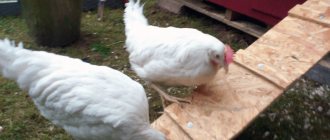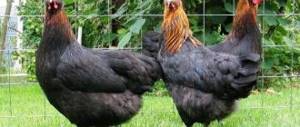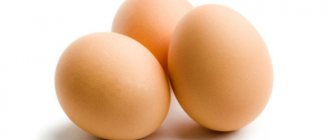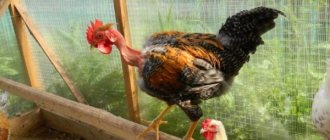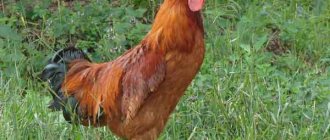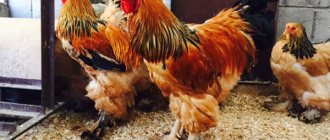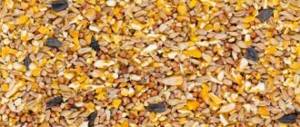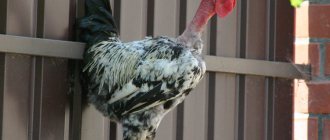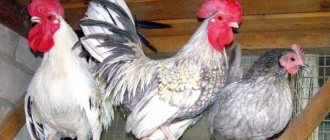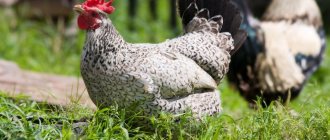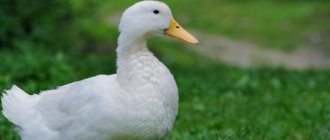Historical reference
Faverolles chickens are the result of crossing two breeds - Manti and Houdan. Initially, birds were raised for the purpose of using them as high-quality broth meat. Over time, crossing with meat breeds (Brahma, Silver Dorking and Cochin) increased their importance and demand in farming.
Faverol salmon chickens, photos and descriptions of which are presented in this material, came to Russia at the end of the 19th century, having previously won the favor of French, European and American poultry farmers. Why is the word “salmon” in the name of the breed?
Initially, few people were interested in the exterior of the bird, since such specimens were unsuitable for exhibitions due to non-compliance with standards. The first representative of the breed that satisfied the requirements of strict judges was obtained in England. German breeders made a significant contribution to improving productive qualities and consolidating external characteristics. It was they who “worked” on the color of the bird, giving its plumage a salmon color, combining shades of red, fawn, orange and yellow.
Hatching chicks
Chickens of the Fireroll breed, like adult chickens, are unpretentious. You can get young eggs from eggs laid by hens older than 9 months (optimally 1-3 years). There should be 5-7 hens per 1 rooster - with this ratio it is possible to achieve a high percentage of fertilization.
Faverole chickens are poor brood hens, so chicks are mostly hatched in an incubator. The collected eggs are cleaned of contaminants using a rag soaked in a solution of potassium permanganate. They are stored for no longer than 6 days at a temperature of +18°C (hatchability decreases over time). Before laying, the incubation material is checked using an ovoscope, disinfected in a bleach solution (15 g/1 l), sorted by size (large specimens are laid first, after 6 hours smaller ones are placed in the incubator).
Until the 18th day, humidity is maintained at 50%, then raised to 78-80%. Temperature until the 18th day: +37.6°C, then it is reduced to +37.2°C. Ovoscoping is carried out after the 6th, 11th and 18th days. Turn the eggs every hour until the 18th day, then stop the process. The total duration of incubation is 20-21 days.
The hatched chicks are allowed to dry completely and transferred to the brooder. In the first days they are fed steamed corn grits and chopped boiled eggs. After 5 days, finely chopped greens, feed yeast, wheat bran, and vegetables are introduced into the diet. At 2 months, chickens begin to be given crushed grains and corn. During this period, the cockerels are separated from the hens.
Description of the Faverol breed
Representatives of the Faverolles chicken breed are outwardly strong and large birds. Cockerels have a small, slightly flattened head, a medium-length neck, and a strong body. The comb is erect, simple, with even teeth. The beak is short, powerful, white (or pink). The eyes are red-orange. The beard covers the underdeveloped earrings and is proportional to the head. The short tail is slightly raised. The wings are placed high and fit well to the body. Five-toed feet. The well-developed fifth digit is longer than the hind digit. Males Faverolles stand out from their fellows with a lush neck collar, richly falling onto the shoulders and partially covering the back. The chest is wide.
Compared to cockerels, the fireball hen (pictured below) looks heavier. The back is wide, slightly raised towards the lower back. The tail is well developed. The neck in the upper region is covered with rich plumage starting below the ears. Behind the ears, some of the feathers are directed upward, towards the back of the head.
Plumage color
The salmon-colored plumage (brownish-red with a slight admixture of white and yellow) is a striking feature of the breed and differs between hens and roosters. Females are covered with feathers of a reddish hue, lighter on the belly and chest area. The neck is dark brown, the tail and “hairstyle” are characterized by the same color. A pale yellow, almost milky color is characteristic of the belly, chest, and legs.
In cockerels, the lower back and collar are ivory-colored, and there are brown-red spots on the sides of the neck. The feathers on the wings are black-mirrored and have a blue-green tint. The lower legs, chest area, abdominal area, beard, sideburns, and lower neck are painted black. Some feathers have a copper-colored border.
Along with salmon colors, there are white, black, blue and silver colors.
Origin
The breed was bred in France. The first individuals appeared there at the end of the 18th century in the village of Faverol, from where they got their name. Individuals belonging to the Manta and Gudan breeds took part in their breeding, which were crossed with Cochin, Brama and Silver Dorking meat chickens.
By the middle of the next century, Faveroli were officially registered as a breed and spread to other European countries and America, and at the end of the same century they appeared in Russia. Now the Faverol breed is kept mainly in the farms of private breeders; in some countries it is bred to participate in exhibitions.
Reasons for culling from a pedigree herd
You can also determine the purity of the fireball chicken breed by the following characteristics:
- The skin of a bird of any plumage color should be white;
- chicks are covered with light yellow down until they are one month old; at 2 months they have sideburns, a beard and their breed coloring.
The disadvantages for which poultry are culled from a pedigree flock include:
- short narrow body or its individual parts;
- thin neck;
- non-horizontal back line;
- lack of hairstyle on the female;
- large scallop;
- absence of the fifth finger;
- insufficient volume of sideburns and beard of the rooster;
- a long tail.
Advantages and disadvantages of the breed
The attractiveness of French chickens is fully conveyed by the photo.
The salmon breed of chickens Faverol is characterized by the following advantages:
- high productivity;
- excellent taste of meat products;
- egg laying throughout the year, even in winter;
- active growth of young animals;
- good adaptation to cold weather.
Like the others, the Faverol breed has a number of disadvantages, including:
- abnormal food consumption, and therefore the tendency of chickens to become obese (due to this, the meat loses its taste);
- rapid loss of productive characteristics when crossed with other breeds.
conclusions
- The bird was bred several hundred years ago in France. During this time, it turned from a meat chicken into an exotic ornamental bird.
- The breed is not common in Russia. In most cases, it is kept by professional breeders to participate in exhibitions and for decorative purposes.
- Birds have good productivity indicators. The meat has excellent taste, the number of eggs per year is about 160 pieces.
- In the photo, the Faverolles chicken looks great. It is distinguished by its massiveness, stateliness and beautiful plumage.
- The birds have a wonderful character. They are friendly and sociable.
- Has a predisposition to gaining excess weight. Therefore, the weight of individuals should be carefully monitored.
- The breed can be bred either with the help of a hen or in an incubator. Hens do not always have a pronounced maternal instinct.
- A fireball definitely needs a walking yard and a spacious poultry house.
- Only dry food is suitable as food.
Egg production
The bird is large, early maturing, actively gaining muscle mass, and is raised for meat. The average weight of roosters is up to 4 kg, hens – 2.5-3.2 kg. The level of egg production is high.
In the first year of laying, this figure is 160 eggs, in subsequent years - 130 or less. The eggs are characterized by a pinkish-brown or yellow-brown shell, each weighing 55-58 grams. There are also dwarf firewoods bred by German breeders. Their weight does not exceed 1 kg, which is fully compensated by their high egg production (120 eggs weighing 40 g per year).
Hens begin to actively lay eggs at the age of 6 months. Eggs are stored at a temperature of no more than +10 °C for 1-2 weeks.
Conditions of detention
The Faverol chicken breed is quite unpretentious in care and does not require special conditions. However, when breeding such a bird, a number of features should be taken into account.
- Due to their large size and heavy weight, it is recommended to keep such birds in spacious enclosures and in a large walking yard, but not in cages.
- It is important to monitor the condition of the litter in the chicken coop and update it in a timely manner. Despite the rich plumage on the paws, which saves birds from the cold in winter, excessive humidity can have a detrimental effect on their health, even to the point of death.
- Faverolles hens love to roam in the soil for a long time in search of food. In a large, spacious yard, this feature of the breed will not only help save on feed, but will also increase the motor activity of the birds.
The nature of the chickens is peaceful, so it is better to keep them separate from overly active birds, because the latter may not get along with such an overly calm breed. Representatives of the fireball breed do not like to run and fly over obstacles, so the farmer does not have to worry about building high enclosures to house them. They can sit or stand in one place for hours, looking at everything around them with interest. Very trusting, they always recognize their owner. Free-range animals rarely get sick, and in the process of searching for food they receive all the necessary vitamins and microelements.
Character of chickens
We recommend reading our other articles
- White radish
- Flour, its types and varieties
- Eggplant King of the North F1
- Andalusian horse
Chickens of this breed have a calm disposition. They get along with other breeds without problems, quickly get used to the owner (in 2-3 days), and are very trusting. Birds are curious, inquisitive and observant. They can simply stand still and look at what interests them for a long time or run around the area squealing for goodies.
The rooster is strong, but not aggressive, does not start fights and usually does not even defend territory. This is both a good and bad trait, because more cocky roosters of other breeds can literally peck at him. So you need to carefully monitor this and do not put roosters of this species in the same coop with fighting males.
The rooster is strong, but not aggressive
Important!
Faverol chickens are not found in poultry farms and poultry farms in Russia, so you can only purchase high-quality, purebred individuals abroad. The birds sold on the market under this name are most often just crossbreeds.
Notes to poultry farmers
According to reviews, the salmon breed of Faverol chickens is quite unpretentious. True, representatives like to climb into the food and scatter it. Therefore, it is recommended to equip the room where birds are kept with hanging feeders. You can also pour food into narrow, deep troughs, separated in the middle by a crossbar.
Many farmers note that the bird often suffers from its heavy weight. There are cases of her falling from the crossbar and getting broken limbs. Therefore, it is recommended to optimally equip the chicken coop with wide round perches and a ladder for easy climbing.
Pitfalls, problems of keeping chickens and their solutions
Fireballs tolerate cold well; high humidity is harmful to them. In a chicken coop, humidity causes outbreaks of disease and death of livestock. To avoid this, you need to change the bedding on time and monitor the condition of the floors and walls. In the warm season, an open enclosure is much more suitable for firewood than a cramped enclosed space.
Faverolles constantly scatter food, climbing into feeders with their paws. A good solution would be to equip hanging feeders or feed the birds from deep troughs with a middle crossbar.
Perch
Birds of this breed are quite heavy and clumsy. If you fall from a perch, there is a high risk of fractures. Therefore, perches for firewood should be low and cylindrical in shape. It is good to equip such a perch with a ladder for climbing. The perch stick should be wide enough: a narrow perch is inconvenient for the paws of firewood, they can slip and fall from it.
Features of feeding
For the successful growth and development of chickens, it is important to correctly formulate a feeding diet, always taking into account their natural tendency to overeat. Nutrition should be balanced, with the obligatory presence of proteins and proteins in the food.
The chickens begin to be fed with crumbly corn porridge with the addition of pureed boiled eggs. Then they transfer to fortified compound feed, add chopped greens, beets, carrots, and wheat bran. After 2 months, corn is introduced into the diet, which, by the way, prevents obesity.
Adult chickens are fed whole grains, vitamin flour, root vegetables, fresh grass, yeast, boiled potatoes, and finely chopped greens.
During the cold period, an excellent basis for steaming feed is whey, skim milk, or a decoction of meat and fish waste. To avoid food stagnation in the stomach, as well as to replenish calcium reserves in the body, many farmers add eggshells and sand to the feed, which have a beneficial effect on digestion. Poultry farmers also recommend feeding ready-made feed containing all the necessary microelements.
How to feed chickens
The diet is complete, otherwise there will be a lack of vitamins and minerals and the birds may develop a wide variety of diseases. Every day they need to be given dry grain and wet mash of greens and root crops and vegetables. With normal feeding, the female produces approximately 2 eggs in 3 days. If productivity is lower, then feeding needs to be improved.
To simplify this task, use simple feed. But it is not cheap, it is much more profitable to give simple feed - grain and mash, adding crushed chalk, meat and bone meal, silage, vegetable cake, premixes.
For normal digestion, there should be a bowl with crushed shells, gravel and sand in the chicken coop and on the run. Drinkers are installed on the run and in the chicken coop so that the birds can always drink enough. It is best to change the water every day so that it does not stagnate, does not get dirty and is always fresh.
In winter, instead of greens, you can give herbal flour or herbal granules
Important!
In winter, instead of greens, you can give herbal flour or herbal granules. Silage or sprouted grain can also be a good alternative.
Breeding
Chickens of the Fireroll breed have almost completely lost their brooding instinct. Even if the poultry farmer manages to place the female on the eggs, there is a high probability that she may abandon the nest at any time. Therefore, to breed young animals of the described breed, it is recommended to use an incubator. Yes, and it is undesirable to incubate a female, because she may subsequently stop laying eggs. The chicks hatch at the same time. They immediately need to be planted on dry bedding and ensure a temperature of +38 °C.
In its pure form, the fireball breed is rare. Mostly used to produce highly productive crosses and lines suitable for industrial breeding. They are kept at home for the purpose of display at exhibitions, as well as for personal use. In this case, the herd should be formed as follows: 5-6 females from one brood and one cockerel from another. Inbreeding within the breed can cause various defects in the offspring. Therefore, young animals should be purchased from different sellers.
In large farmsteads, hens are kept until they are 6 or 7 years old for the purpose of incubating eggs and hatching chicks. According to farmers, faverolles chickens in the household are a profitable investment. In a short period of time, all costs associated with their acquisition are fully recouped by their productivity.
